On a curtain of vinyl strips are projected two reproductions of Henri Matisse’s painting La Danse. Even in their dematerialized, doubled state the dancers are instantly recognizable, but after several seconds they vanish, replaced now by a Warhol portrait of Mao that is paired with a Mondrian Composition. The sequence continues, a parade of Van Goghs, Cézannes, Kandinskys, and Klees all flashing across the curtain seemingly at random, as if they accompanied an absent art history lecture that disregarded all pretense of chronological or stylistic organization.
This work by Lea Lublin, Dedans le musée/Pénétration d’Images (1971), invites the viewer to behold these familiar works and then pass through the curtain, at once metaphorically entering their pictorial spaces and enacting their physical rupture. Appropriately, it enjoys pride of place at The Museum of Modern Art’s compelling, dizzying Transmissions: Art in Eastern Europe and Latin America, 1960–1980, dominating a small gallery at the heart of a show that foregrounds a widespread ambivalence towards prevailing artistic trends shared by artists on both sides of the Atlantic, who sought not only to engage with such trends but ultimately reshape them.
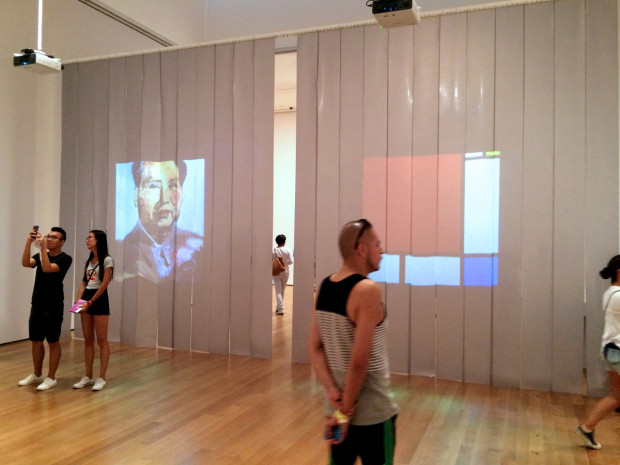
Photography: Sean Nesselrode
A collaborative effort by curators Stuart Comer, Roxana Marcoci, and Christian Rattemeyer, the show is drawn almost entirely from the museum’s permanent collection, with nearly half of the three hundred works on display for the first time at MoMA. The majority of these are recent acquisitions that have come to the museum thanks to the efforts of C-MAP (Contemporary and Modern Art Perspectives), an in-house initiative dedicated to pushing beyond the warhorses on view in Lublin’s installation to focus on comparatively understudied work from Asia, Eastern Europe, and Latin America. Transmissions is the first major curatorial intervention to result from C-MAP and the latest in a recent line of MoMA exhibitions that, in welcoming new figures into a pantheon of twentieth- and twenty-first century art history, have found the museum playing a long overdue but much welcome game of catch-up. Latin America has recently been spotlighted in retrospectives of Lygia Clark, Horacio Coppola, and Grete Stern, with Joaquín Torres-García next in line; Central and Eastern Europe have been represented by Isa Genzken, Sigmar Polke, and Alina Szapocznikow.
The museum’s commitment to expanding its purview has remained largely artist-specific, or region-specific in the case of last season’s exhaustive Latin America in Construction. What makes Transmissions unique in comparison is its consideration of a well-trod theme—namely, artists’ experimentation during the 1960s and 1970s—from the vantage point of two disparate regions that, at first glance, seem to have little in common beyond their shared status as peripheral zones, as designated by the political geography of the Cold War. (Mercifully, the exhibition dispenses with maps as an expository conceit.)
A tour through the show, however, complicates the coherence of this apparent duality. If we are taking the artists to be representational of their respective geographies, the list of countries included is fairly selective (Argentina, Brazil, Chile, Poland, Romania, and former Yugoslavia emerge most prominently), but these are hardly stable entities. In most cases the artists refuse to be pinned down by nationality. Lublin is a particularly resonant case study, as she unites the titular regions of Eastern Europe and Latin America with that of Europe, the fabled center. Born in Brest, Poland, Lublin studied painting in Buenos Aires after her family emigrated in 1931. She eventually settled in Paris where she remained for the rest of her life, turning to performance and film as her media of choice. It becomes clear that borders mean very little in the expanded art history of Transmissions, and the show’s most persuasive passages are those that emphasize circulation, translation, and exchange across transnational networks. Trans- becomes the operative prefix.

Photography: Sean Nesselrode
Much of Lublin’s work explicitly deals with the weight of art history, particularly that of capital-M Modernism, and in this sense her Dedans le musée is emblematic of the show as a whole: the meticulous arrangements of the Mondrian Composition, when projected onto the vinyl strips and viewed from the other side of the curtain, become fractured and flipped. The Mondrian is no longer a Mondrian, but something else beyond recognition. This invocation and deformation of the abstract avant-garde is precisely where Transmissions begins, opening with a series of bold experiments in abstraction by artists who, like Lublin, straddle multiple nationalities. The sculptures of Mira Schendel and Gego, two European expatriates to South America, bend and twist geometry into deceptively complex, affective forms, while Jesús Soto and Lucio Fontana—who traveled from South America to Europe—push the picture plane beyond its two-dimensional limits: the former projects outward with wires that appear to shiver and melt into the painted support, the latter famously slashing the canvas to glimpse a void that lies beneath the surface. This introduction firmly establishes the restless artistic scene at the onset of the decade, but it also astutely focuses on the collective engagement that characterized the period. In the first gallery alone there are appearances by GRAV (Groupe de Recherche d’Art Visuel) in Paris, Nove Tendencije in Zagreb, and Grupo Frente in Rio de Janeiro.
From there things detonate, with a set of very different artist groups whose combative gestures and militant stances inject a decidedly more anarchic sentiment that characterizes the majority of Transmissions. This section skews more Eastern European, with the Yugoslav group Gorgona most extensively featured in the form of its shape-shifting eponymous journal and the linguistic experimentations of founding member Mangelos, but the Venezuelan collective El Techo de la Ballena also makes a strong showing. Though situated in completely different contexts half a world away from one another, both groups shared an interest in destabilizing the conventions of society and culture. They favored manifestoes and public interventions over the sanctity of the art object (in the show they are grouped under the “anti-art” banner), and they indulged in a taste for the grotesque: the name of the former derived from the Greek Gorgon, while the latter made a mascot of the mythical Leviathan.
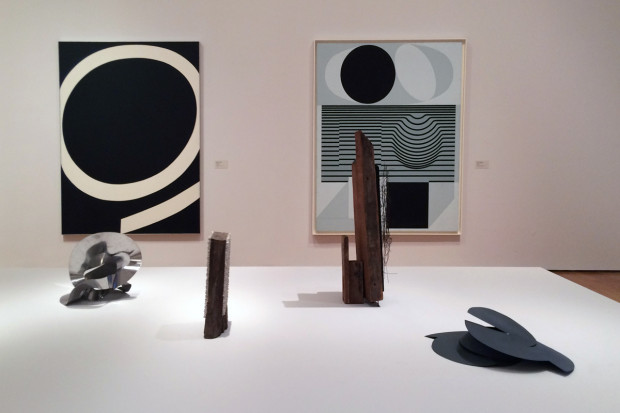
Photography: Sean Nesselrode
This second “anti-art” section is demonstrative of the show’s strategy as a whole, which is to unite a series of disparate artists and collectives, with an aim to make sense of the messiness. Across eleven galleries, Transmissions gathers together an abundance of material—it encompasses painting, sculpture, film performance, street interventions, mail art, print matter, and multimedia installations—and attempts to organize everything into a relatively linear version of postwar art history, which begins with the problem of abstraction and then proceeds to dissolve the boundaries between those most familiar of categories, art and life. After irreverent performative eruptions in public urban spaces (Gorgona, El Techo de la Ballena), we see the ascendance of information and technology (David Lamelas, Marta Minujín), the radicalization of art as activist critique (VALIE EXPORT, Ewa Partum), the rise of the poster as a genre for revolutionary subversion (with an emphasis on Poland and Chile), and the turn to conceptual art (Greta Brătescu, Luis Camnitzer, Juan Downey).
If this all seems like the same story of postwar art told with different characters, that is because for the most part it is. Part of this is due to the fact that the work in Transmissions actively engaged with or responded to artistic trends developing in Europe and the United States. These trends allowed artists, who were negotiating climates of comparable political and economic instability, with tools that allowed them to circumvent restrictions upon freedom of expression and to eschew the growing pressures of the international art market. The curators’ strategy of stressing vanguard practices and thematic commonalities, rather than grouping artists together strictly by country, foregrounds these connections while also grounding the work in terms familiar to MoMA’s audience. But as many of these terms (e.g. conceptual art, feminism) come out of a predominantly Western framework and map somewhat obliquely onto the work presented, this tactic comes with its own potential pitfalls. It runs the risk of flattening histories or resorting to formalist comparisons, something that happens all too often in attempts to realize a “global art history.” A gallery devoted to representations of the family in contexts of social inequity is one of the few times the exhibition stumbles, inexplicably placing Oscar Bony’s still-shocking La familia obrera—a piece from 1968 in which the artist paid a working class family double their typical wages to be exhibited as art—alongside works that would be more typically classified as Pop, such as the garish, disquieting Lullaby (1970) by Beatriz González, whose deliberately kitsch renditions of political, religious, and artistic icons on found furniture still remain criminally undervalued outside her native Colombia.
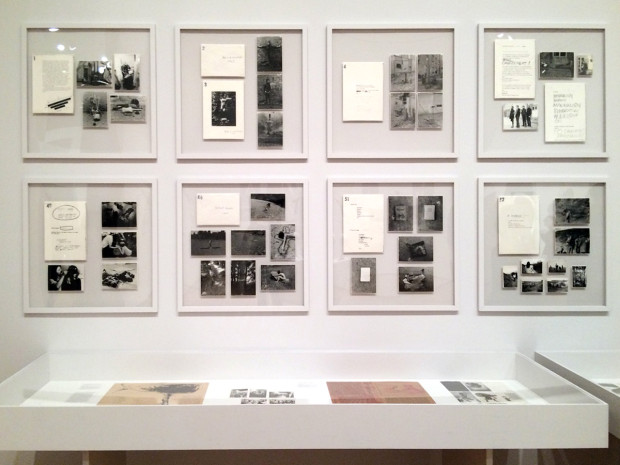
Photography: Sean Nesselrode
More often, however, the framework of the show allows for surprising juxtapositions that complicate the neat categories into which the work has been slotted. Liliana Porter’s hybridizations of photography and drawing, for example, are now firmly in the canon of conceptual art, but their upending of medium specificity gains an added potency when viewed in concert with the hypnotic, cameraless Radiograms of Bela Kolárova (1962–63) and the frottaged geometries of Dóra Maurer’s Hidden Structures (1977–80). At other points, the show departs from its insistence on identifying cross-cultural resonances to zoom in on specific groups or movements for which international exchange was integral. A gallery devoted to the Argentine avant-garde based at the Instituto Torcuato Di Tella is a standout, with David Lamelas’s newly recreated 1968 installation Office of Information about the Vietnam War at Three Levels: The Visual Image, Text and Audio converting the gallery space into a multilingual site of information distribution. Nearby, Marta Minujín’s happening Simultaneidad en Simultaneidad, produced in collaboration with Allan Kaprow and Wolf Vostell in 1966, interrogates the veracity of media communication through a series of “invasions” occurring simultaneously across three continents.
Given the wide net cast by Transmissions, the exhibition functions by necessity as an introductory survey. This is due especially to the presumed unfamiliarity of the artists and movements profiled: even an expert in Latin American art, for instance, would be surprised by the work produced in Eastern Europe (and vice versa), to say nothing of the casual visitor. There are maybe ten smaller exhibitions contained within the vast scope of Transmissions, and by the time I reached the concluding installation of Juan Downey’s Video Trans Americas (1976)—a video diary that short-circuits the stability of ethnographic representation while proposing a transcontinental American identity—I found myself utterly bewildered. To the show’s credit, it was a state of invigorated optimism rather than frustration.
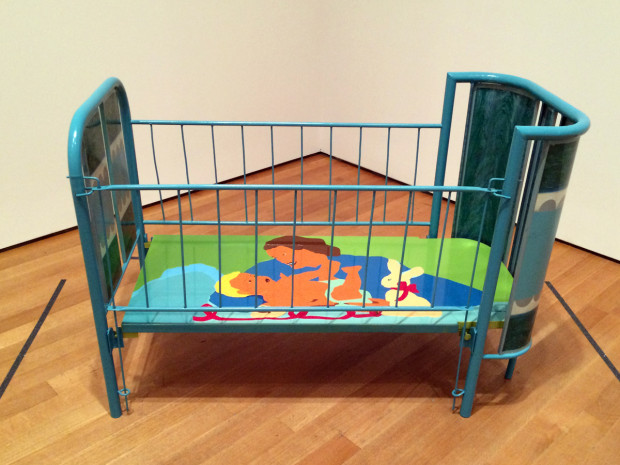
Photography: Sean Nesselrode
Lublin’s Dedans le musée is placed opposite the artist’s Interrogations sur l’art (1971), a piece that trades images for text and poses a series of rhetorical questions that are colorfully stenciled against a modernist grid: “Is art illusion? Is art thought? Is art self-knowledge? Is art a concept?” These seem to be the questions that, regardless of their geographic disparities, the artists in Transmissions grappled with as they confronted cultural and political hegemonies. They are also questions that the museum seems to be asking itself at a moment of institutional crossroads: this voyage into uncharted territory (for this museum, at least) arrives even as MoMA is doubling down on its modernist credentials. For me, the most exciting aspect of the exhibition is that it represents a promising first step, a willingness on the part of this institution to dive into murky waters, not just to rethink the narratives it has canonized but more importantly to reveal new ones that have been forgotten or overlooked. The task of the museum, now, is to push itself beyond mere introduction and pursue more in-depth considerations of the artists it has brought into its gallery spaces. As evidenced by the wealth of related essays and interviews uploaded to C-MAP’s online resource post, there is still much work to be done.
The first time I visited Transmissions, not a single visitor was willing to accept Lublin’s challenge to penetrate the image, and all those Picassos, Matisses, and Mondrians remained intact. The second time, one person passed through a projection of a Kandinsky abstraction, and I must confess I felt a rush of exhilaration when the image broke apart before my eyes. Hopefully, with future shows, tightly focused on specific artists or moments that continue to question the shape of modern and contemporary art history, more of us will feel comfortable to step through to the other side of the curtain.

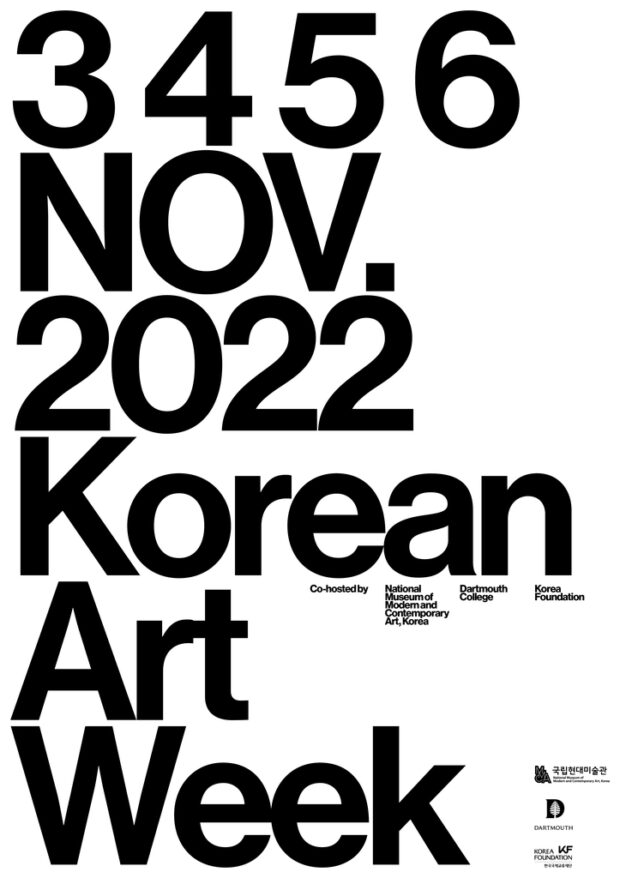


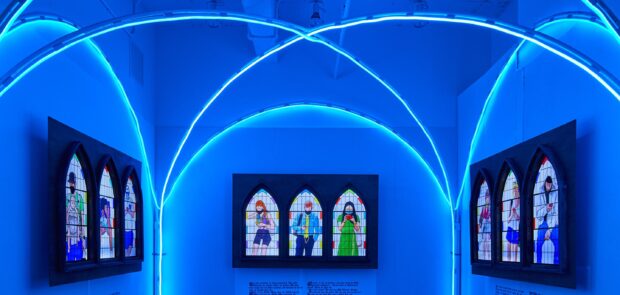

Be First to Comment